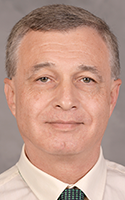By Sergey Kravchick, M.D.
 Scrotal pain or testalgia (testicular pain) has been defined as testicular pain when it occurs for more than three months. Pain is usually perceived in the testes, epididymis or the vas deferens. It was estimated that 2.5 percent to 4.8 percent of visits to the urologist are for chronic scrotal pain. Most men are in their mid to late 30s, although the condition can occur from adolescence to older age.
Scrotal pain or testalgia (testicular pain) has been defined as testicular pain when it occurs for more than three months. Pain is usually perceived in the testes, epididymis or the vas deferens. It was estimated that 2.5 percent to 4.8 percent of visits to the urologist are for chronic scrotal pain. Most men are in their mid to late 30s, although the condition can occur from adolescence to older age.
Despite the numerous possible causes, in 25–50 percent there is no definite source. The mechanism of acute pain is not fully understood, but recent research found a markedly higher number of nerve fibers with the evidence of degeneration in the spermatic cord nerves in men with testicular pain. There are two special forms of scrotal pain syndrome. The first is the post-vasectomy scrotal pain syndrome, which occurs in 2-20 percent of men who have undergone a vasectomy. The likelihood is higher six months after vasectomy and 2-6 percent of these patients have a VAS score greater than 5 (visual analog scale from 0 to 10 points). The second form is post-inguinal hernia repair and its frequency is significantly higher after laparoscopic rather than open operations.
Diagnosis
History and physical exam are the most important diagnostic tools. History should focus on onset, duration, severity (graded on a 0–10 scale), location and referral of pain. Further evaluation includes a urinalysis, urine and semen culture if indicated. A duplex Doppler scrotal ultrasound should be performed to rule out structural abnormalities. MRI scan of the spine should be obtained if there is a history of back pain. In patients with elevated red blood cells count in urine CT scan should be considered to exclude renal colic.
When initial work-up for scrotal pain failed to detect etiology, a reasonable next step is spermatic cord nerve block, which is performed by injecting bupivacaine or lidocaine into the spermatic cord. Successful pain relief is helpful in both diagnosis and in determining whether microsurgical spermatic cord denervation will be effective as a treatment.
Treatment
It should be started with nonsteroidal anti-inflammatory drugs (NSAIDs) and antibiotics, particularly when there is evidence of infection. Doxycycline and quinolones are best, as they appear to have the highest penetration into these structures and may be given up to four weeks if indicated. Other oral agents include antidepressants, such as Amitriptyline and Nortriptyline, or anticonvulsants such as Neurontin (Gabapentin). However, these drugs are not beneficial for post-vasectomy pain.
Epididymectomy could be used when the pain is localized to the epididymis and appears to have its best outcomes following vasectomy. However, its efficacy for treatment of other forms is very low. Vasectomy reversal (vasovasostomy) can be offered in patients after vasectomy and it can completely or partially relief the pain in 75 percent and 10 percent of the patients.
Microdenervation of the spermatic cord (MDSC) became the most effective treatment for the patients who didn’t respond to medical treatment. The goal of the operation is to divide all neural fibers, but to preserve the arteries (testicular, cremasteric, deferential). The key selection measure for this procedure is a positive yet temporary response to a spermatic cord block. Upstate Urology offers all of these treatment modalities to patients with scrotal pain syndrome.
Physician Sergey Kravchick specializes in general urology, endourology, male health: chronic prostatitis/chronic pelvic pain syndrome and testicular pain and practices at Upstate Urology at UHS and Wilson Hospital in Binghamton.
